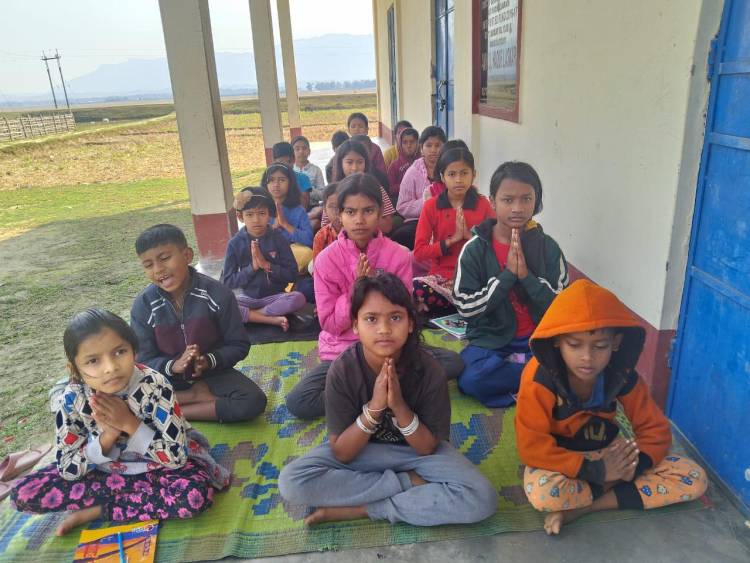[GHHF] Bala Samskar Students of Assam learned about the history and significance of Kasi Viswanth Temple
 So far as I am able to judge, nothing has been left undone, either by man or nature, to make India the most extraordinary country that the sun visits on his rounds. Nothing seems to have been forgotten, nothing overlooked.” Mark Twain
So far as I am able to judge, nothing has been left undone, either by man or nature, to make India the most extraordinary country that the sun visits on his rounds. Nothing seems to have been forgotten, nothing overlooked.” Mark Twain
Global Hindu Heritage Foundation of Assam elected to teach about the history and significant events Kasi Viswanath Temple went through to make out students aware of the unforgettable history of Kasi Viswanath Temple. The Kashi Vishwanath Temple in Varanasi, Uttar Pradesh, is one of the twelve Jyotirlinga shrines in India. It was originally known as the Adi Vishveshwar Temple but was destroyed by Mohammad of Ghor during his invasion. Later, under Mughal Emperor Akbar, the temple was rebuilt with the efforts of Man Singh I and Todar Mal. However, in 1669, Emperor Aurangzeb ordered the demolition of the temple, and a mosque, the Gyanvapi Mosque, was constructed on the site in 1678. Despite this, Hindu pilgrims continued to visit the temple’s remnants. In 1780, the Maratha queen Ahilyabai Holkar of Indore built a new structure on an adjacent site. In 2021, a major redevelopment project, including the Kashi Vishwanath Mandir Corridor linking the temple to the Ganga River, was completed. This has significantly increased the temple’s visitor numbers, making it one of the most visited Hindu temples in India.
The following are the significant events dating back to ancient times:
Ancient Times
The origins of the Shri Kashi Vishwanath Temple are rooted in antiquity, with mentions in the Skanda Purana. The temple is believed to have been established in Varanasi, known as Kashi, where Lord Shiva manifested himself as a Jyotirlinga, symbolizing his eternal presence and blessing.
1194 CE
The ancient Vishwanath Temple is destroyed by Qutb-ud-din Aibak’s forces, and a mosque is erected in its place. Despite this, the spiritual significance of the site remains, with Hindus continuing to venerate the location.
1230 CE
A Gujarati merchant reconstructs the temple, but it is later destroyed again by Hussain Shah Sharqi and Sikandar Lodhi during their rule.
1585 CE
Raja Todar Mal, under the patronage of Mughal Emperor Akbar, rebuilds the temple, but it faces boycotts from traditional Brahmins due to his daughter’s marriage to an Islamic ruler, leading to its eventual destruction once more.
1669 CE
Mughal Emperor Aurangzeb orders the final destruction of the original Kashi Vishwanath Temple and the construction of the Gyanvapi Mosque on its site. The temple’s original Jyotirlinga is hidden to protect it from desecration.
1780 CE
Maharani Ahilyabai Holkar of Indore rebuilds the temple near the site of the Gyanvapi Mosque, restoring its significance as a central place of worship for Hindus
Maharaja Ranjit Singh of Punjab donates gold to plate the temple’s domes, earning it the nickname “Golden Temple.” This act symbolizes the temple’s revival and continued importance in Hindu worship.
1833-1840 CE
Several neighboring temples and ghats are constructed around the Gyanvapi well, with contributions from various Indian royal families, further enhancing the temple’s spiritual and cultural significance.
1860 CE
The Rana of Nepal donates a large stone statue of the Nandi bull, which still stands at the temple today, signifying the temple’s enduring connection to its devotees.
Post-Independence Era
The temple complex continues to grow, with the surrounding areas becoming increasingly significant as pilgrimage and cultural sites.
2019-2021 CE
The Kashi Vishwanath Corridor Project is initiated and completed, dramatically transforming the temple complex by improving accessibility and enhancing the pilgrimage experience. The corridor connects the temple directly to the Ganges River, further integrating the temple into the spiritual landscape of Varanasi.
2022 CE
The temple’s sanctum sanctorum is gold-plated, thanks to a donation of 60 kg of gold by an anonymous South Indian devotee, marking the latest chapter in the temple’s ongoing history of renewal and devotion. (Source: https://temples. org/ shri-kashi-vishwanath-temple/}
Your donations are appreciated.
By Zelle: ghhfusaorg@gmail.com
PayPal: savetemples.org
By Check: Or you can send a check payable to GHHF, 14726 Harmony Lane, Frisco, TX 75035.
It is tax-deductible.
By Rupees: call 601-918-7111; +91 83096 43979




















 Urgent support needed for Bangladesh Hindus
Urgent support needed for Bangladesh Hindus 







